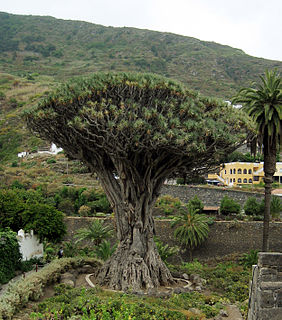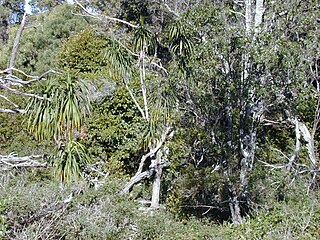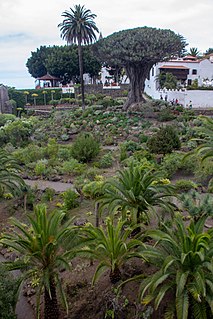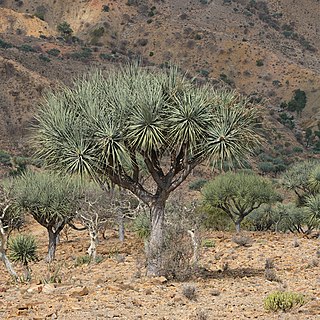
Dracaena is a genus of about 120 species of trees and succulent shrubs. The formerly accepted genera Pleomele and Sansevieria are now included in Dracaena. In the APG IV classification system, it is placed in the family Asparagaceae, subfamily Nolinoideae. It has also formerly been separated into the family Dracaenaceae or placed in the Agavaceae.

Dragon's blood is a bright red resin which is obtained from different species of a number of distinct plant genera: Calamus spp. also including Calamus rotang, Croton, Dracaena and Pterocarpus. The red resin has been in continuous use since ancient times as varnish, medicine, incense, and dye.

Dracaena draco, the Canary Islands dragon tree or drago, is a subtropical tree in the genus Dracaena, native to the Canary Islands, Cape Verde, Madeira, western Morocco, and is thought to be introduced in the Azores. Its closest living relative is the dragon blood tree of Socotra, Dracaena cinnabari.

Dracaena sanderiana is a species of flowering plant in the family Asparagaceae, native to Central Africa. It was named after the German–English gardener Henry Frederick Conrad Sander (1847–1920). The plant is commonly marketed as "lucky bamboo".

Cordyline is a genus of about 15 species of woody monocotyledonous flowering plants in family Asparagaceae, subfamily Lomandroideae. The subfamily has previously been treated as a separate family Laxmanniaceae, or Lomandraceae. Other authors have placed the genus in the Agavaceae. Cordyline is native to the western Pacific Ocean region, from New Zealand, eastern Australia, southeastern Asia and Polynesia, with one species found in southeastern South America.

Dracaena reflexa is a tree native to Mozambique, Madagascar, Mauritius, and other nearby islands of the Indian Ocean. It is widely grown as an ornamental plant and houseplant, valued for its richly coloured, evergreen leaves, and thick, irregular stems.

Sansevieria is a historically recognized genus of flowering plants, native to Africa, notably Madagascar, and southern Asia, now included in the genus Dracaena on the basis of molecular phylogenetic studies. Common names for the 70 or so species formerly placed in the genus include mother-in-law's tongue, devil's tongue, jinn's tongue, bow string hemp, snake plant and snake tongue. In the APG III classification system, Dracaena is placed in the family Asparagaceae, subfamily Nolinoideae. It has also been placed in the former family Dracaenaceae.

The wildlife of Rwanda comprising its flora and fauna, in prehistoric times, consisted of montane forest in one third the territory of present-day Rwanda. However, natural vegetation is now mostly restricted to the three National Parks and four small forest reserves, with terraced agriculture dominating the rest of the country.

Dracaena fragrans, is a flowering plant species that is native throughout tropical Africa, from Sudan south to Mozambique, west to Côte d'Ivoire and southwest to Angola, growing in upland regions at 600–2,250 m (1,970–7,380 ft) altitude. It is also known as striped dracaena, compact dracaena, and corn plant.

Dracaena cinnabari, the Socotra dragon tree or dragon blood tree, is a dragon tree native to the Socotra archipelago, part of Yemen, located in the Arabian Sea. It is named after the blood-like color of the red sap that the trees produce.

Pleomele is a former genus of flowering plants. All its species are now placed in the genus Dracaena. The Hawaiian name for plants in this genus is hala pepe, which translates to crushed or dwarfed Pandanus tectorius.

Dracaena aurea, the golden hala pepe, is a species of flowering plant that is endemic to the island of Kauaʻi in Hawaii. It inhabits coastal mesic and mixed mesic forests at elevations of 120–1,070 m (390–3,510 ft). It is a small evergreen tree, usually 4.6–7.6 m (15–25 ft) tall, but sometimes reaches 12 m (39 ft). The gray, straight trunk does not have bark and is 0.3–0.9 m (0.98–2.95 ft) in diameter. The sword-shaped leaves are 20–51 cm (7.9–20.1 in) long and 1–3 cm (0.39–1.18 in) wide.

Dracaena aletriformis is commonly known as the large-leaved dragon tree. These plants are found in forest in the eastern areas of South Africa from Port Elizabeth to northern and eastern Limpopo. They are also found in Eswatini, but are most common in the coastal and dune forests of KwaZulu-Natal.
Artitropa erinnys, the bush night-fighter, is a butterfly of the family Hesperiidae. It is found from the East Cape to KwaZulu-Natal, Transvaal, Zimbabwe and eastern Africa.

Drago Park is a park and one of the main visitor attractions in Icod de los Vinos, Tenerife. Created at the turn of the millennium, it contains El Drago Milenario, a dragon tree thought to be around 1,000 years old, as well as a variety of other native plants.

Dracaena ombet, commonly known as Gabal Elba dragon tree, is a species of plant belonging to the Asparagaceae family, formerly included in the Ruscaceae. It is found in northeastern Africa and the western Arabian Peninsula.
Dracaena transvaalensis, the Wolkberg dragon tree, is a medium-sized tree in the genus Dracaena found in the Olifants River Valley near Penge in the Limpopo and the adjacent Wolkberg. It looks similar to Aloe. The plant is considered rare.
Dracaena jayniana is a species of plant in the genus Dracaena. It was described by Paul Wilkin and Piyakaset Suksathan in 2012. It is known as Chan daeng in Thai. The specific epithet is named for Jayne Spasojevic, a donor to a school in Portfield, Dorset.

Dracaena steudneri, the northern large-leaved dragon-tree, is a species of flowering plant in the family Asparagaceae, found from Ethiopia to southern tropical Africa. It is being investigated for its high-quality fiber content. It is fed upon by larvae of the bush nightfighter, Artitropa erinnys. In the past the name Dracaena steudneri was erroneously assigned to the well-known ornamental and house plant Dracaena fragrans, called the cornstalk dracaena, striped dracaena, compact dracaena, and corn plant, leading to much confusion.

Dracaena arborea, the tree dracaena, is a species of flowering plant in the family Asparagaceae, native to western and west-central wet tropical Africa. It is used as a street tree in a number of African and Brazilian cities.















